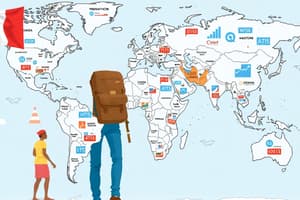Podcast
Questions and Answers
What is a primary driver behind labor migration?
What is a primary driver behind labor migration?
- Family reunification
- Economic disparities between countries (correct)
- Environmental changes
- Desire to travel for leisure
Which type of migration involves individuals seeking to join family members already settled abroad?
Which type of migration involves individuals seeking to join family members already settled abroad?
- Asylum migration
- Family reunification (correct)
- Unauthorized migration
- Labor migration
What type of migration occurs when individuals flee their countries due to persecution or conflict?
What type of migration occurs when individuals flee their countries due to persecution or conflict?
- Environmental migration
- Asylum migration (correct)
- Unauthorized migration
- Economic migration
Which factor could lead to environmental migration?
Which factor could lead to environmental migration?
What defines unauthorized migration?
What defines unauthorized migration?
What can be an impact of global migration on host societies?
What can be an impact of global migration on host societies?
Which statement about global migration is NOT accurate?
Which statement about global migration is NOT accurate?
Which reason is a primary factor driving humanitarian migration?
Which reason is a primary factor driving humanitarian migration?
What is a major motivation for Filipinos migrating abroad as Overseas Filipino Workers (OFWs)?
What is a major motivation for Filipinos migrating abroad as Overseas Filipino Workers (OFWs)?
Which of the following is a pro for sending countries regarding migration?
Which of the following is a pro for sending countries regarding migration?
What is a potential con for receiving countries due to migration?
What is a potential con for receiving countries due to migration?
What is a characteristic of immigration policies in some countries?
What is a characteristic of immigration policies in some countries?
What does the Global Compact for Migration aim to achieve?
What does the Global Compact for Migration aim to achieve?
Which of the following can be a challenge caused by migration for sending countries?
Which of the following can be a challenge caused by migration for sending countries?
What is a key requirement for addressing the challenges of global migration?
What is a key requirement for addressing the challenges of global migration?
What is a foreign expatriate's primary motivation for migrating to other countries?
What is a foreign expatriate's primary motivation for migrating to other countries?
What is a significant factor that drives labor migration between countries?
What is a significant factor that drives labor migration between countries?
Which of the following is NOT a political factor contributing to migration?
Which of the following is NOT a political factor contributing to migration?
How does climate change contribute to migration?
How does climate change contribute to migration?
What aspect of society and demography can drive demand for migrant labor?
What aspect of society and demography can drive demand for migrant labor?
Which impact do migrants usually have on the economies of their host countries?
Which impact do migrants usually have on the economies of their host countries?
What is one consequence of migration related to cultural diversity?
What is one consequence of migration related to cultural diversity?
What challenges can migration pose to host countries?
What challenges can migration pose to host countries?
What trend is observed in global migration flows?
What trend is observed in global migration flows?
Flashcards
Global Migration
Global Migration
The movement of people across international borders, driven by various reasons including economic opportunities, conflict, and environmental factors.
Labor Migration
Labor Migration
Movement of people to another country for better job opportunities, higher wages, or improved working conditions.
Family Reunification
Family Reunification
People migrating to join family members already settled in another country.
Asylum Migration
Asylum Migration
Signup and view all the flashcards
Environmental Migration
Environmental Migration
Signup and view all the flashcards
Unauthorized Migration
Unauthorized Migration
Signup and view all the flashcards
Voluntary Migration
Voluntary Migration
Signup and view all the flashcards
Forced Migration
Forced Migration
Signup and view all the flashcards
Economic Disparities
Economic Disparities
Signup and view all the flashcards
Political Instability
Political Instability
Signup and view all the flashcards
Environmental Changes
Environmental Changes
Signup and view all the flashcards
Demographic Changes
Demographic Changes
Signup and view all the flashcards
Economic Impact (Migration)
Economic Impact (Migration)
Signup and view all the flashcards
Cultural Diversity Impact
Cultural Diversity Impact
Signup and view all the flashcards
Labor Market Dynamics
Labor Market Dynamics
Signup and view all the flashcards
Social Integration Challenges
Social Integration Challenges
Signup and view all the flashcards
OFW
OFW
Signup and view all the flashcards
Brain Drain
Brain Drain
Signup and view all the flashcards
Remittances
Remittances
Signup and view all the flashcards
Cultural Diversity
Cultural Diversity
Signup and view all the flashcards
Impact of Migration on Sending Countries
Impact of Migration on Sending Countries
Signup and view all the flashcards
Impact of Migration on Receiving Countries
Impact of Migration on Receiving Countries
Signup and view all the flashcards
Global Compact for Migration
Global Compact for Migration
Signup and view all the flashcards
Migration Policies
Migration Policies
Signup and view all the flashcards
Study Notes
Global Population and Mobility
- Global migration is a defining feature of global dynamics, encompassing economic mobility and humanitarian refuge
- Individuals migrate for opportunities, safety, and new beginnings
- Migration is voluntary (e.g., vacations, reunions) or forced (e.g., seeking employment, asylum, or trafficking)
Global Migration Types
- Labor: People move for better jobs, higher wages, or improved work conditions, often due to economic disparities between countries
- Family Reunification: Individuals migrate to join family members already settled in another country
- Asylum: People flee countries due to persecution, conflict, violence, or natural disasters, seeking refuge under international refugee law
- Environmental: People migrate due to environmental disasters like drought, flooding, sea-level rise, or other changes impacting livelihoods
- Unauthorized/Illegal: Some migrants enter countries without legal permission or overstay visas, often due to lack of legal pathways or economic hardship (including trafficking victims)
Factors Impacting Global Migration
- Economic: Disparities in income, job opportunities, and living standards between countries drive labor migration
- Political: Political instability, conflict, persecution, human rights violations, and lack of political freedom lead to seeking safety in other countries
- Environmental: Climate change and environmental degradation can displace people seeking suitable environments
- Society and Demography: Demographic changes like aging populations in developed countries can drive demand for migrant labor in healthcare and eldercare
Impact of Migration on Countries
- Economy: Migrants often contribute to economies in both host and home countries (through labor and taxes, remittances to home countries)
- Cultural Diversity: Migration enriches societies with new languages, traditions, cuisines, etc.
- Labor Market Dynamics: Migrants fill labor shortages, but also face exploitation and discrimination
- Social Integration: Successful integration depends on policies promoting inclusion in education, healthcare, and employment
- Political and Policy Challenges: Migration affects border control, security, social cohesion, and public perception
Trends & Patterns in Migration
- Significant migration flows from developing to developed countries and within similar regions
- Examples include migration from Latin America to the US, Middle East and Africa to Europe
- Filipinos are a major overseas worker group (OFWs) motivated by labor needs
Impacts of Migration on Sending vs. Receiving Countries
- Sending Country: Remittances can boost local economies, but there is loss of skilled labor (brain drain)
- Receiving Country: Migrants fill labor shortages, enrich culture, and contribute to economic growth, but potentially face social cohesion challenges, integration problems, and pressure on public services
Global Governance and Cooperation
- Addressing the challenges and opportunities of global migration requires international cooperation, adherence to human rights, national-level and international-level policies
- Policies vary widely; some countries adopt open policies, while others impose strict controls
- Global Compact for Migration aims to manage migration safely and orderly
Studying That Suits You
Use AI to generate personalized quizzes and flashcards to suit your learning preferences.




